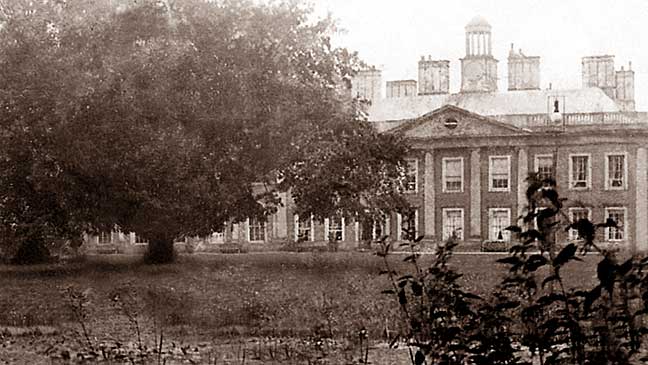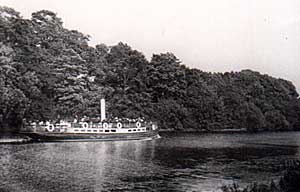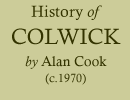< Previous | Contents | Next >
Colwick Hall

Colwick Hall, c.1910.
The history of Colwick Hall as a manor house or a homestead, has been traced back to the beginning of the 10th century. Possibilities of it having existed well before this time are present, but no records have come to light so far, perhaps future developments of the park may turn up evidence for the archaeologists to work on.
The first owner was the Saxon, Godwin, and the homestead was contained in a timber enclosure and was surrounded by a moat. It continued like this until after the Conquest, for at the time of the Domesday Book, Walan or Waleraun held it “of the fee of Peverell, and of the King in Capite”, by twelve barbed, arrows, when he came to Nottingham Castle. This fee or rent was still paid, if asked for in 1504, when the Byrons were in possesion.
Early in the 12th century, the de Colwick family were holding the park as it was called in an Inquisition, dated 1280, which stated that Sir Reginald de Colwick and Phillip, his son “enclosed their park with hedge and ditch.” The manor house of this period, which was still enclosed by a deep moat, was built of stone, quarried from the foot of the hill to the north of the house. From information we have of Edwardian manor houses, we presume that it looked as follows:- a long, low, range of one storied buildings, with the kitchens and domestic offices in the east, the private apartments on the west, and a high roofed chamber in the centre, known as “the hall” where the family and retainers lived. This house was used by all the de Colwicks and maybe the early Byrons, but we assume that the Byrons either remodelled the house or entirely rebuilt it.
All these old buildings were pulled down and the moat filled in about 1775 to make room for the present Hall, which was built in 1776 by a local man, Mr. Samuel Stretton, of Lenton, and the architect was Mr. John Carr, of York a contemporary of Robert Adam.
The design is mostly taken up with brickwork and the ornamentation in stonework, following the style of the period. With the exception of the classical stone loggia, which forms the main entrance between the wings on the north front, (the side seen from Colwick Road) this side is mainly composed of plain brickwork, sliding sash-windows, with stone architraves and dressings. This giving the impression that it is the back of the house instead of the front. The south or river front, which is hidden from general view by the trees, is more imposing. It is composed of a central pavilion, two storeys in height, surmounted by a heavy cornice and parapet, having a pediment in the centre, carried on four bold Ionic columns. On either side of this central pile, there is an extended one storied wing; the west end contains the ballroom at the rear, (the front two rooms on this side have been used as a public house since 1892) and the domestic apartments in the east wing. A range of stabling and offices was erected in 1778, which have been altered twice since the Racecourse took over, a little further east, well-appointed kennels were erected at the same time, which now stand in ruins.
The internal decoration of the hail includes some beautiful Spanish mahogany doors, with enriched mouldings and architraves, an elegant main staircase with an elaborate mahogany balustrade, enriched plaster ceilings and cornices, Multi-coloured marble chimney-pieces, etc., all carried out in the “Adams style” of this period.
Between the south front and the river is a backwater with a reed-bed, which could be mistaken for part of the moat and has been called a lake.
Before the modern flood prevention schemes were thought about, the hall and grounds had been protected from flooding, by a large flood bank, which has been built for a considerable distance on both sides of the hail. It is composed of soil and rock which was again taken from the quarry.
The wrought iron gates belonging the hail were found in the mud of the backwater, about 1885, when the vestry and organ chamber were added to the church, and workmen were searching for any stone to harmonise with the rest of the building. The original stone pillars were still attached to the gates. The leaf and scrollwork of the gates, which are still preserved in the Nottingham Castle Museum, is identical to other examples of this period. It is evident that they were torn down and thrown in the mud by the rioters in 1831. According to an account given in the local newspaper, by a person who was living before the railways were put down, states that the Park (now known as Colwick Woods) was separated from the road by a high brick wall, of which only a short stretch is still left at the side of the Midland Railway embankment. Anyone who required access to the park had to first go down to the hall to ask Mr. Musters, for the key to the gate. Part of the wall which enclosed the kitchen garden is still left, but the Round House, which was built into this wall and an adjoining cottage, were demolished in 1967. (the remainder of the wall was removed in 1974).

Steamer at Colwick, 1904.
In the early 1900s, steamers used to ply between Trent Bridge and a Landing stage at Colwick Park for 3d per return trip. Three steamers were engaged on this run, the Queen and the Sunbeam, each had for entertainment, a harpist, a violinist, and a concertina player, while the largest of them, the Empress, even had a baby grand. When the trippers arrived at Colwick Park, they were entertained by pierrots on the lawn, a menagerie, high divers, rare Australian black swans on the lake, and three fine public bars and a restaurant. A steam D.C. generating plant had been installed in a glass building, where the crowds could see it producing the new-fangled electricity to light thousands of coloured fairy lights to illuminate the trees, both in the park and along the riverbank. The Hall first became a public house when the racecourse was opened, and the rest of the house was used to accommodate grooms and jockeys overnight. It is now being redeveloped as an hotel.
The Park has been used for many different things since the Musters sold it, such as Agricultural Shows, Army Camping Ground during part of both wars, Fire Service Training Ground, but the most historic moment in this century, was on the 30th September, 1910, when French airman, de Lessops, flying a Bleriot monoplane at a flying display at Burton-on-Trent, lost his way and made a forced landing in the park grounds. This could possibly have been the first plane to land in the County of Nottinghamshire.
The only change made in the park when the Railways were laid down, was that the road had to be moved farther away from the woods than its original line and one of the Lodges belonging the Hall was removed for the road bridge to be put up.
